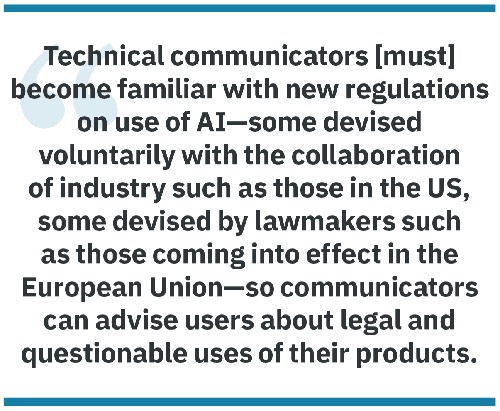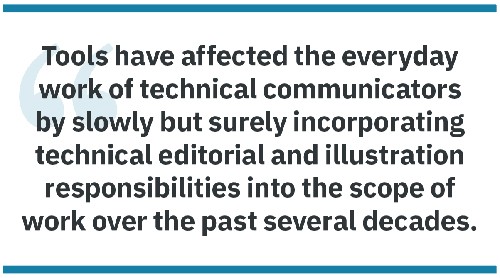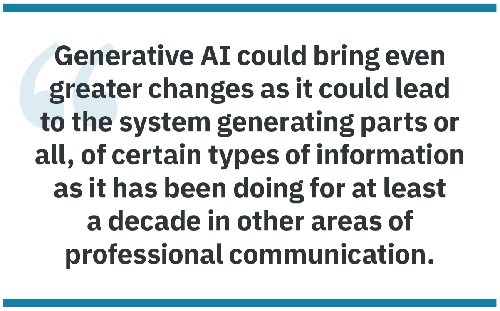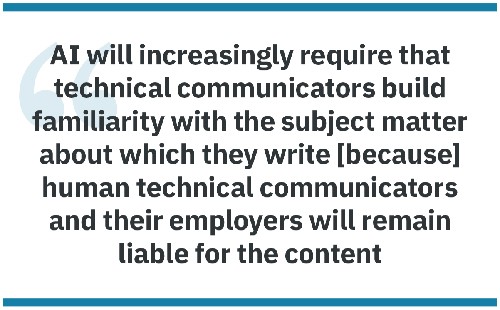By Saul Carliner | Fellow and Samira Karim
Despite the relatively recent introduction of ChatGPT, AI technologies have played an increasing role in the work of technical communication over the past decade and more.
Years ago, a colleague with whom Saul began his career as a technical communicator observed that, by the 2020s, our jobs would involve helping to pull together pieces of information from various sources and tailor that information to the users’ needs—all on the fly. When she first mentioned it to me in the late 1980s, online information was just starting to appear, and the majority of information remained in print.
Looking at technical communication today, she seems like a soothsayer. Many of the components needed to realize her vision are already in place and many others are coming into place. Technologies associated with artificial intelligence (AI) have played a major role in that. Although the release of a public version of ChatGPT at the end of 2022 fueled the current interest, AI technologies have had an ever-increasing impact on the work of technical communicators for decades and will continue to do so.
After providing a brief background definition of AI, we explore the two ways AI has affected the work of technical communicators: as a subject about which we write and as a work tool. When doing so, we also anticipate ways that AI might further address our work.
About AI
Although an in-depth explanation of AI falls well beyond the scope of this article, a short one might be beneficial, especially within the context of technical communication.
AI refers to the ability of machines to mimic the capabilities of humans. These include the ability to:
- Replicate human actions (like touch and speak)
- Sense (such as visual and audio recognition)
- Perform human tasks with information (such as translate it, correct its spelling, and write and review content)
- Make inferences about the information (such as characterizing audiences and predicting their informational needs).
- Solve problems and make decisions (such as assessing job applicants).
AI as the Subject of Our Work
Recently, one technical communicator proudly shared his latest job. He works for a company that produces software that can recognize license plates. Law enforcement agencies use the software to help track and catch suspects. Viewers of the television franchises FBI and Law & Order have seen such software in use. One of the aspects of his work that the technical communicator values is his ability to contribute to public safety.

This highlights one of the ways AI affects technical communicators: as a technology about which we communicate. At the least, aspects of AI have been increasingly integrated into the software that technical communicators document, such as (but not limited to) increasingly sensitive search capabilities, prediction capabilities (such as systems that can automatically re-order products, assess credit risk, and suggest adjustments of farming care to address different microclimates), and voice capabilities (like chatbots that take voice input).
At the most, AI capabilities are also integrated into physical products. Some are new categories of products like robots that can deliver orders to customers in restaurants and assist with resident care in long-term care facilities. Some are more traditional products like refrigerators that can help build shopping lists, and automobiles and cars, which can take voice commands, have increasingly sophisticated entertainment consoles, and can automatically handle some driving tasks (with full self-driving on the way).
For these, technical communicators will need familiarity with the type of AI used, how customers should use these “intelligent” products, how service professionals should support and repair such products, and the ability to explain this to the affected audiences. That responsibility poses challenges because AI allows for mass-customizing of product use—that is, different applications with different audiences—and because many of the uses might not be anticipated by the product developers.
Some technical communicators might also have responsibility for documenting the algorithms that guide decisions and actions by the AI. Such documentation is a legal requirement in some jurisdictions. In others, it could be central to any potential lawsuit, a liability that most companies can anticipate. Documenting the algorithms becomes more of a challenge when systems can automatically adjust them based on “learning” that occurs through everyday operations.

Communicating about these products could also affect the way technical communicators work. One way that could happen pertains to work processes, especially for those who work on physical products that incorporate AI. As Roy and White (2024) note, with the introduction of AI, the release schedules for many of these products will shift from the traditional schedule of six months to five years to continuous release of the software components, much like mobile apps and other software, where upgrades are released as soon as they become available. Right now, even when software is built into products, it generally is not updated. This move to continuous release, in turn, changes the process of developing products to an ongoing one, changing peak-and-valley experiences into something more akin to an assembly line. Technical communicators will need to adjust to a different work rhythm.
Communicating about these products coupled with the need to document algorithms also increases the need for technical communicators to develop familiarity with product limitations and liabilities, which they need to communicate to users. For example, one of the issues raised by the software that tracks license plates mentioned earlier is the ability for its use outside of law enforcement. That, in turn, requires that technical communicators become familiar with new regulations on the use of AI—some devised voluntarily with the collaboration of industry such as those in the U.S., some devised by lawmakers, such as those coming into effect in the European Union—so communicators can advise users about legal and questionable uses of their products, somewhat like medical writers need to prepare disclaimers about the uses of medication and medical devices.
AI as Part of Our Work Processes and Tools
At an advanced instructional design workshop in which instructional designers presented their recently produced tutorials for critique by their peers, one showed a tutorial with clear, but “tinny” narration; it sounded machine generated. The participant commented that they used a feature in Articulate Storyline that generated the narration from a script.
Later in the same workshop, another participant also showed a narrated tutorial. The second narration sounded significantly better than the first, and participants assumed the narrator was a professional. They assumed wrong; the second narration was generated by a newer version of Storyline. The technology had progressed significantly in a few short months.
This happened more than a decade ago at Lakewood Media’s Training conference in San Diego. Since then, AI has increasingly affected the work of technical communicators from analysis of a project through design, development, and delivery of the content.
Analysis. AI can summarize background readings, analyze data about audiences and make predictions about them. In addition, voice technologies can automatically transcribe interviews with subject matter experts. Some of these technologies have been in use for years (such as data analysis and transcription tools) while others are newer (like summarizing tools).
Design and Development. The impact of AI on these activities seems to have captured the most attention. Some AI-related technologies have been in use for years, including voice technologies that not only allow for system-generated narration in tutorials and show-me videos, but also can allow technical communicators to dictate their work, should they choose.
Other AI-related technologies have assisted technical communicators for years (often without our realizing that some sort of intelligence was involved), including tools that:
- Provide editorial assistance, starting with checking spelling (hence the name, “spellcheck”), later checking grammar and now, advising on style.
- Check the accessibility of documents, noting features out of compliance with guidelines so communicators can fix them.
- Produce both text and voice chatbots.
- Automatically translate text, significantly speeding up translation and facilitating simultaneous release of technical information in several languages, something not feasible in the past. Recently, translation capabilities have started to appear in word processors and similar applications.
- Produce and retouch images, from correcting photographs and illustrations to generating images and animations.
- Publish documents on several platforms—print-like (PDF), computer and laptop screens, and mobile screens—from a single file. Systems automatically adjust the presentation to the device. Similarly, tools like Design Ideas in Microsoft PowerPoint offer guidance in the appearance of slides and other documents.
These tools have affected the everyday work of technical communicators by slowly but surely incorporating technical editorial and illustration responsibilities into the scope of work over the past several decades, resulting in a small percentage of technical communicators describing themselves primarily as editors (3.5%), a larger percentage as writers (24.6%), and the largest percentage (36.9%) describing themselves as writers/editors (Carliner and Chen, 2018).

Generative AI could bring even greater changes as it could lead to the system generating parts or all, of certain types of information as it has been doing for at least a decade in other areas of professional communication. For example, the co-pilots (AI tools) in Microsoft Word and PowerPoint suggest that they can assist or prepare first drafts, addressing blank screen syndrome.
More broadly, AI can handle routine writing tasks. Bloomberg has used system-generated headings since 2013 and system-generated earnings reports since 2018. Sports Illustrated and the news chain Gannett have used AI to generate sports summaries for several years (Tyrangiel, 2023). The types of information that seem ripe for this approach involve material that comes from existing sources (like product specifications or the Internet) and follows a particular format or template in presentation.
AI also affects delivery of information. The transition from printed to online information in the 1980s through 2000s also saw a transition from linear multi-page manuals to shorter topics that users can easily find and browse. Based on the tracking of user performance in applications that is facilitated by standards like the Experience API (which can assess skills), intelligent tools will not only track what users can perform but also can suggest which assistance and training they might need and when they might need it.
AI can assist managers with hiring technical communicators. Automated Tracking Systems help employers identify qualified applicants from their existing pools of applications (not just for a current opening but also past ones). “Scrubbers” that go through social media can also find potentially qualified applicants to recruit. Some organizations conduct screening interviews with automated tools that pose questions to applicants and make recordings, which AI tools analyze to choose finalists.

In addition to affecting the work of technical communicators as described here, AI will increasingly require that technical communicators build familiarity with the subject matter about which they write. That seems paradoxical because AI can summarize source documents, speeding up advance research, and later, generate text. But human technical communicators and their employers will remain liable for the content and, as has been demonstrated in some recent situations—such as that of a time-pressed attorney who submitted court briefs generated by ChatGPT that referred to non-existent precedents—AI tends to make up facts (called hallucination) (Cerulla, 2023). And as that attorney was sanctioned by the court, so technical communicators could find themselves liable for inaccurate information in their documents.
What This Means to Technical Communicators
Although ChatGPT seems to have flashed onto the scene, if the past is any guide, the impact of AI is likely to be incremental: AI affecting a product or process about which we write; one or two job responsibilities adjusted at a time with the introduction of one or two new capabilities aided by AI in the tools we use to perform our jobs. The rest of this issue of Intercom explores some specific applications of AI technology to our work.
References
Carliner, Saul, and Chen, Yuan. “What Technical Communicators Do.” Intercom 65, no. 8 (2018): 13-16.
Cerulla, Megan. “A Lawyer Used ChatGPT to Prepare a Court Filing. It Went Horribly Awry.” CBSNews.com, May 29, 2023. Accessed January 14, 2024. https://www.cbsnews.com/news/lawyer-chatgpt-court-filing-avianca/.
Roy, Abhirup., and White, Joseph. “At CES, Legacy Automakers Scramble to Keep Up in AI Arms Race.” The Globe and Mail, January 12, 2024. Accessed January 13, 2024. https://www.theglobeandmail.com/drive/article-at-ces-legacy-automakers-scramble-to-keep-up-in-ai-arms-race/.
Tyrangiel, Josh. “What Sports Illustrated’s BotGate Really Means for Journalism.” Washington Post, December 1, 2023. Accessed December 10, 2023. https://www.washingtonpost.com/opinions/2023/12/01/ai-sports-illustrated-bot-journalism/.

|
Saul Carliner is a Professor of Educational Technology at Concordia University in Montreal. He is Fellow and past president of STC. Contact: saulcarliner@hotmail.com |

|
Samira Karim is an IT professional and a PhD student in Education at Concordia University in Montreal. Her research focuses on studying content curation and AI. Contact: samira.karim@mail.concordia.ca |


